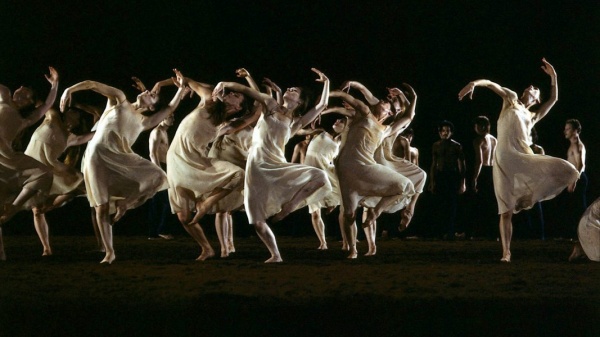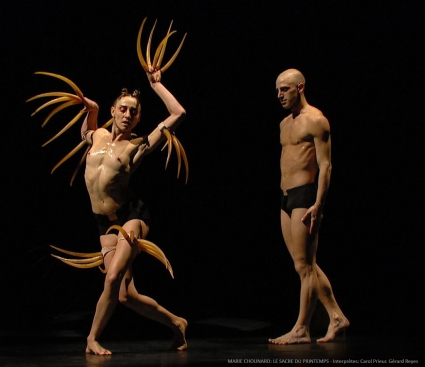CONTROLLED CACOPHONY — CHOREOGRAPHER MARIE CHOUINARD
Posted by Deirdre | Filed under Blog
The hard, percussive accents of Igor Stravinsky’s Le Sacre du Printemps (The Rite of Spring) have inspired Montreal choreographer Marie Chouinard to create a highly original work of contemporary theatrical dance that is like a volcano erupting, a well of pure force.
Originally created in 1993 for her 11-member Compagnie Marie Chouinard, and inspired by the original Vaslav Nijinsky ballet of 1913, her Sacre du Printemps is rooted in primal experience.
In the piece, the dancers are seen for the most part under bright spotlights whose circular or rectangular shapes (designed by Alain Lortie) highlight them against a blackened backdrop, making them look like biological specimens under glass.
Significantly, their movements have an evolutionary quality about them, starting from low-to-the-ground fetal positions and growing, or rather mutating, into full body shapes that include dynamic leaps, jumps and twists through the air.
Chouinard, a former soloist who started her own company in 1986, looks at life as two opposing but complementary forces. On a literal level, these forces are male and female. But Chouinard, an iconoclast known (for better or worse) as the enfant terrible of Canadian dance for her controversial choreography, is rarely literal. So what you get here is not men and women but rather ideas or interpretations of masculine and feminine cosmic energies.
The initial scene features a stage floor awash in blue light and what looks like a grove of ochre horns. The lighting suggests the sea — the liquid, soft, warm fluid of life — while the phallic set design by Zaven Pare suggests the hard, flinty matter of the Earth.
The dancing itself is both hard and soft. All the dancers, male and female, accentuate the natural curves of the body with rounded, undulating movements for the torsos, arms and legs. The choreography also calls for hyper extended chests and buttocks. These poses have various effects. With backsides protruding, the dancers look like Balinese temple sculptures, exotic, sensual and mysterious. With their chests sticking out, they look like peacocks.
The bird imagery is consistent with other parts of the dance where the dancers, two at a time, stand almost nose to nose with quick back and forth head movements like pecking chickens. In other instances, the dance imagery is more feral, with the dancers evoking wild, stalking beasts. There’s also a hint of equine imagery in the stallion-like way the dancers paw at the floor with their bare feet, or gallop in a stationary position like hobbyhorses. And when the dancers adorn themselves with the horns from the previous scene, they look like sea anemones, languidly vibrating.
Chouinard found this imagery in the music, a revolutionary score from 1911 whose controlled cacophony is the aural equivalent of cataclysmic life experiences such as birth, death and the creative process.
That process is brilliantly captured by Montreal composer Rober Racine’s sonic accompaniment to the Stravinsky score, which features the sound of a pencil drawn furiously across a piece of paper to suggest a sudden burst of creative writing.



